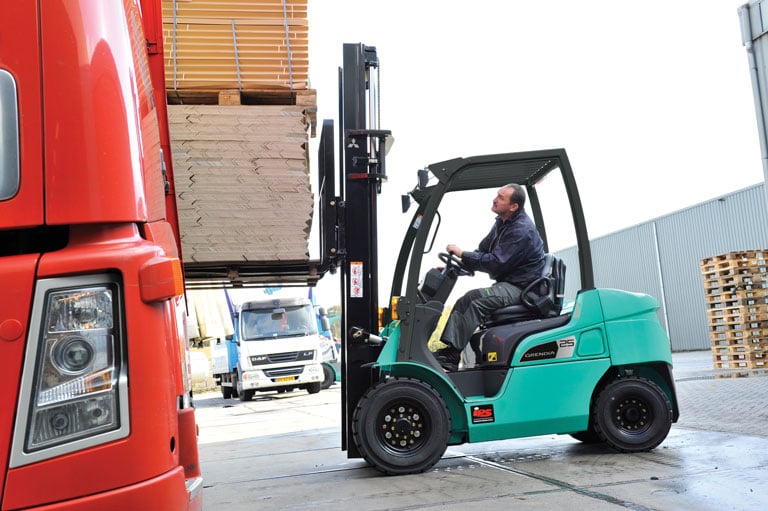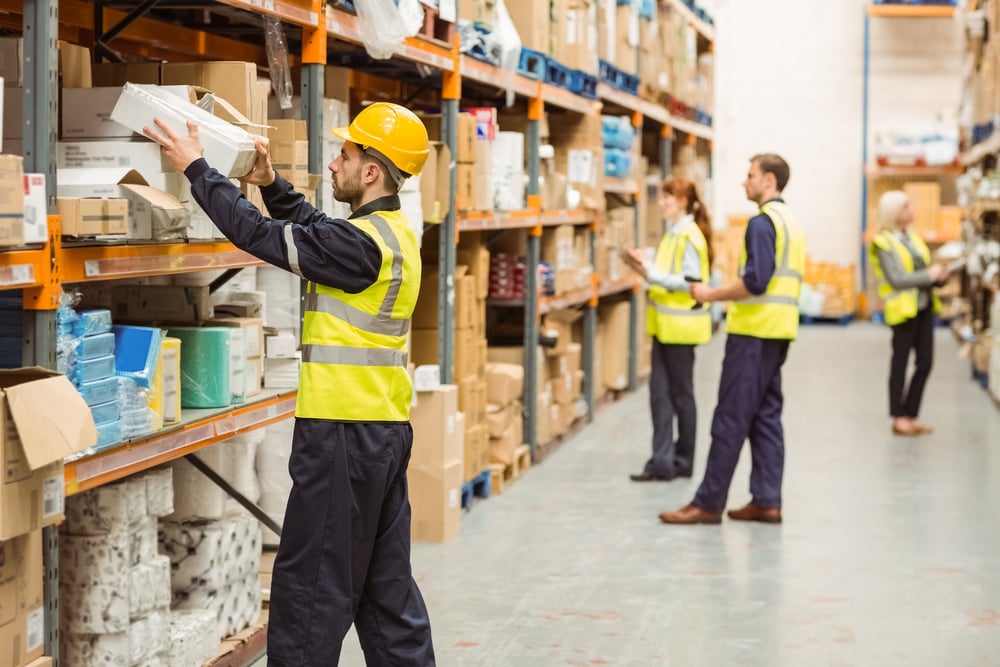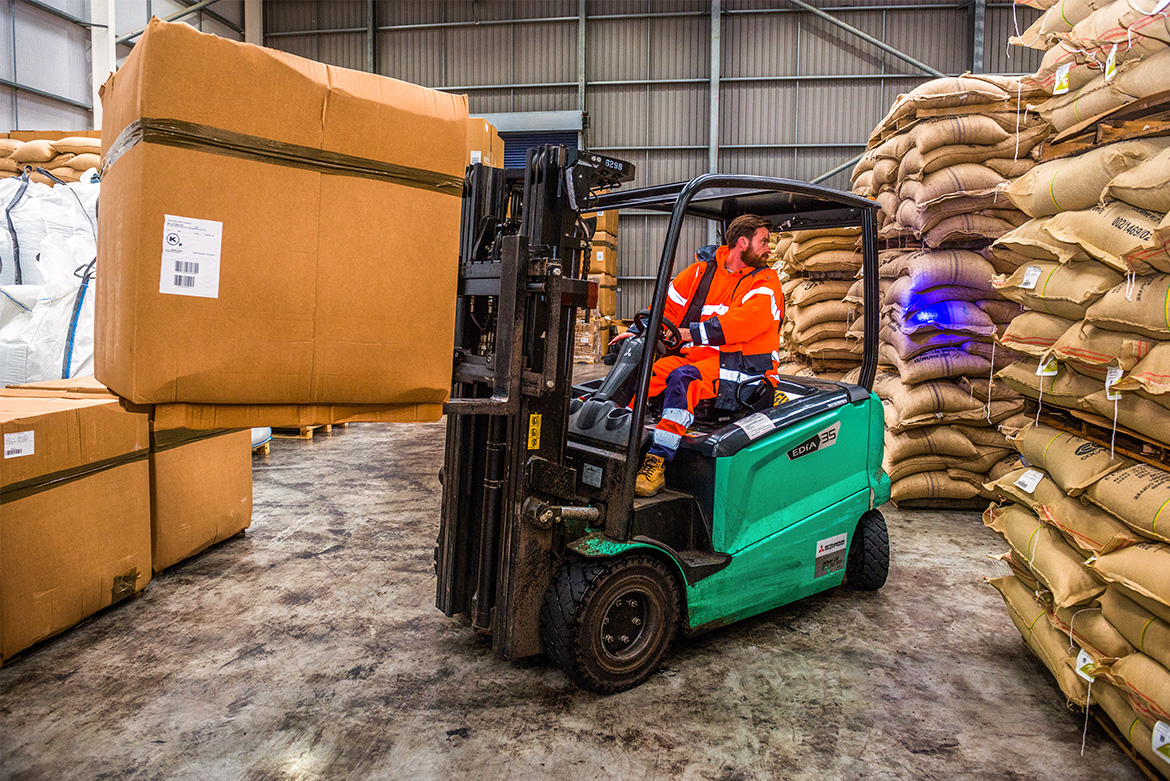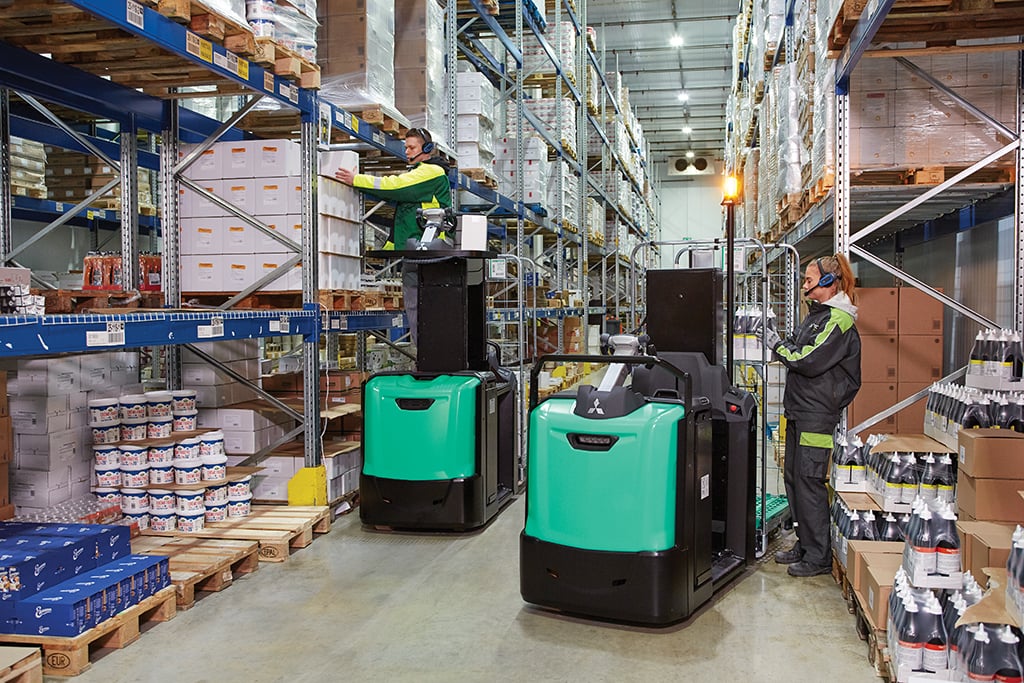Safety, applying the right machine for the task at hand, ergonomics, training, warehouse tidiness, leasing, ensuring your warehouse is up to scratch, and investing in electrification are all important aspects of your complex material handling operations that will affect you both in terms of finance and maintaining productivity within your operations.
Read on to discover the eight steps you can take to reduce your material handling costs.
8 steps to reducing your material handling costs
1. Use the right machine for the right operation
You must use the correct forklift truck and other material handling equipment for the right kind of application or handling.
There's a huge range of trucks currently on the market, and new trends and demands in a changing industry mean that innovation in material handling equipment isn't going to stop any time soon. Trucks are the backbone of any warehouse operation, and in certain stages of the supply chain, particularly during a costly stage like order picking, the choice of truck can greatly impact efficiency and your bottom line. In fact, research shows that using a pallet truck, for example, can offer up to 40% quicker transport compared to a pedestrian truck, saving you both time and money.
However, choosing the correct truck can be difficult. Your warehouse, your drivers, and the kind of goods you handle can affect the decision. And certain trucks, such as stand-in stackers, are versatile machines, which can be used for a number of different operations, depending on your needs.
The right truck should enable the driver to do their job in the most efficient manner. It should be well integrated into the handling system and be an efficient unit in the total truck fleet. Research shows that around 65% of warehouse operational budgets are spent on labour. Allocating the right machine for the right equipment can reduce your labour costs whilst enhancing safety (thus, reducing the costs associated with accidents or injuries).
Choosing the wrong truck can lead to big losses in efficiency and can increase your costs. Simulation technology can help you discover which piece of equipment is right for your operations. The technology makes it possible to monitor handling regularly to determine which trucks give the best handling results. If you’re not able to access this technology, experts such as those at Mitsubishi Forklift Trucks are always on hand to offer professional advice.
2. Ensure you’re operating safely
Safety requirements must be satisfactorily met by all equipment and at all stages of handling. Within your material handling operations, safety will cover a wide range of concepts; from the physical work environment, trucks and equipment to individual compliance with instructions and laws.
Truck computers
Modern trucks are typically equipped with a computer which monitors all functions. This intelligent addition helps the operator work safely by indicating if there is a fault or giving a warning before a breakdown occurs. With a Mitsubishi truck, to be able to drive a truck with a fitted computer the driver must state their personal identification number (PIN code); the computer will register the truck’s operations and the driver can be informed if they have made any mistakes, driven recklessly, or if there are any issues with the truck that might compromise the safety of the driver or surrounding pedestrians.
Racking
When working with racking, there’s always a risk of the racking collapsing or tipping over which has the potential to damage operators, goods, equipment, or the warehouse itself. It’s important not to overload racking and carry out regular inspections. This also reigns true for loading bays. You can avoid accidents on loading bays by securing loading ramps. The ramps can also be fitted with a guard to stop trucks driving onto the lorry, and signal systems can improve loading bay safety.
Driving
Driving a truck of any kind can bring considerable physical strain to the operator, particularly on the neck, shoulders and left arm (from heavy steering). Investing in ergonomic equipment and proper training will help the driver operate more comfortably and efficiently whilst reducing the risk of injury.
Here are 9 basic rules to prioritise safety:
- The operator must be trained and authorised to operate the forklift
- Inspect the forklift before operating
- Always wear the seat belt, if available, whilst operating the forklift
- Do not allow anyone on any part of the forklift while operating
- Do not allow anyone to stand or walk under the elevated portion of the forklift
- Do not travel with the load above a safe transport height
- Do not exceed the truck’s lift capacity
- With obstructed views, drive in the opposite direction
- Do not forget to remove the key from the ignition/log off when leaving the truck
If you’re dealing with dangerous, hazardous, theft-prone goods or items that are sensitive to water damage, you may need to explore specific safety regulations. Ensuring you’re adhering to the correct safety levels can help to enhance efficiency which will reduce your costs.
The more aware everyone is of safety and safety measures, the more likely it is that operators will be able to work in a comfortable environment with minimal risks of danger, damage, or injury. Factors such as ensuring operators have all-round vision, that trucks have the latest technology, and the environment they’re operating in is up to scratch, will reduce the risk of accidents and make your material handling operations run more seamlessly, thus reducing your costs.
3. Invest in ergonomic equipment
Driving a forklift is a taxing job, and drivers becoming significantly less effective, or even requiring time off work due to strain and injury is common. By focusing on the ergonomics and safety of your trucks and warehouse environment, you can reduce these factors; minimising injury, improving efficiency, and lowering your costs.
Forklift trucks have been around for over 100 years, but the issue of workspace design and ergonomics has become increasingly important in the last 30 years. Whereas the focus of manufacturers was previously on occupational safety, there are now many solutions and equipment variants that can protect the drivers from strain, allowing them to maintain performance and minimise the risk of injury.
A study by the Gothenburg's Chalmers University of Technology, in cooperation with the Mitsubishi Forklift Trucks, has shown that forklift drivers turn their heads more than 1,000 times per hour, and make up to 2,000 arm movements in the same period. In light of rising personnel costs and longer working lives due to demographic change, the protection of health above and beyond the statutory requirements is increasingly becoming a focus for employers.
77% of all forklift accidents are impact accidents, 33% of which happen while reversing. (Source: Energie Textil Elektro Medienerzeugnisse)
Driving a truck can be a considerable physical strain. The most vulnerable areas are the neck, shoulders, and left arm (from heavy steering). Remember that good ergonomics is essential to sustainable productivity. The more intensive the driver’s stint, the greater the need for ergonomic design. Investing in ergonomic equipment will increase operator comfort, safety, and efficiency, which ensures you’re reducing your material handling costs.
At Mitsubishi Forklift Trucks, we offer an integrated joystick as standard , with which all the major functions of the lift mast can be controlled. This makes the forklift easier to operate, saves time and increases the handling rate.
4. Ensure operators are fully trained
You can’t underestimate the importance of training and the impact it can have on the safety of your operators, the efficiency of your operations, and the overall cost of your material handling.
Regular in-service training of truck drivers has been shown to give extremely positive results, and supervisors must remain up to date on the latest rules and regulations, too.
The right training can reduce or prevent costly injuries and damage. Minimising the risk of injuries within your material handling operations is essential, as is productivity; the ability of the truck driver is highly important – a fully trained driver will operate with higher speed, accuracy and efficiency which positively affects productivity.
Training can be seen as a fairly large investment, especially if you operate a large fleet. However, the cost can quickly pay for itself if it results in less damage and wear to your trucks, more effective material handling, and less downtime for maintenance, battery changing, and leave taken due to injury.

5. Prioritise order and tidiness
Maintaining order and tidiness within your material handling operations is essential to a good work environment. It’s not just about aesthetics – order and tidiness affect productivity. These factors play their part in increasing performance and reducing your material handling costs.
A poor working environment can be a primary cause of accidents. Keeping everything tidy and in good working order can minimise injuries and damage to both warehouse operators, equipment, and the goods you store. As everyone becomes more aware of safety measures and rules relating to warehouse organisation and structure, they become more responsible for ensuring rules are followed.
No matter how skilled the operator is, a high pace of work is often impossible to achieve if there are issues in the warehouse such as pallets being out of position, inadequate handling areas and obstacles in the aisles.
In most warehouses, more than one system or method of storage is used. Different systems have different advantages, and making the right decision goes a long way towards creating a rational and efficient goods flow. The choice of storage system is mostly guided by three main factors:
- The range of merchandise
- The frequency of demand
- The rate of turnover
Depending on your industry and the goods you handle, space usage and handling methods will differ. It’s important, then, to ensure the storage system you use is the right one if you are to maintain order and tidiness in your warehouse so that you’re not compromising on productivity.
6. Consider leasing as a viable option
If you’re looking for a new forklift which will provide years of faithful service, rather than just a short-term hire truck to help you deal with busy periods, your first thought may be to purchase one outright. Although this is the best option for some, if you're trying to reduce your material handling costs, leasing could be an option for you.
Leasing a truck over long periods of time brings many of the same benefits as full ownership, while also offering you many significant advantages of its own.
You get a committed, long-term relationship with your supplier
When you sign a leasing contract, it marks the start of a long-term partnership between you and the supplier. Having a close relationship with your supplier can be useful if you plan to change your fleet in the future. Better still, the supplier is contractually committed to supporting your truck – so if problems arise, you won’t be on your own.
You get a direct link to a ‘one-stop shop’ for equipment and service support
A major benefit of leasing directly from the supplier is the simplicity it brings. If you want to bring on new equipment, or need service when a truck has problems, you can rely on your established relationship and contract with the supplier to solve your problems.
Easy access to the latest equipment
Since a leasing contract is for a finite period (often three, four, or five years), when it expires, it will be replaced by a new contract which will involve the supply of a new replacement truck. This new truck will have design improvements such as optimised health and safety features, greater operator comfort, and higher energy efficiency.
Access to in-house expert service engineers
When your lease includes a service agreement, you’ll have access to your supplier’s specifically trained engineers, who have a deep knowledge of their own equipment, as well as a comprehensive stock of spare parts available, and easy access to any other required parts.
You deal with an in-house finance company (depending on your supplier)
Certain suppliers will make use of in-house financing, rather than an external financing company or a bank. This makes the supplier more flexible when it comes to arranging the terms of your agreement.
Material handling is a busy and complex industry, and having less to think about when it comes to service, supplier relationships and your finances may provide a positive change to your business and your bottom line. If this sounds like something that could work for your company, consider leasing.
7. Ensure the warehouse itself is up to scratch
Physically improving the working environment will ensure seamless productivity and employee satisfaction, two components that, together, guarantee consistent operations.
One small part of a logistics operation can have knock-on effects in other areas. Issues such as climate, lighting, the warehouse floor and loading bays can all contribute to an increase in downtime – by improving and optimising these areas, you can increase productivity and efficiency with relatively little effort or cost.
The climate
Naturally, cold stores for frozen or refrigerated goods are very expensive to build and operate, making efficient use of the available storage space especially important. But in any kind of warehouse, the climate is an important consideration. Draughty and unevenly heated premises make the work environment uncomfortable, impairing staff performance and potentially undoing the environmental improvements you may have made to your equipment or processes.
Lighting
Forklift driving is a delicate and often dangerous operation, and drivers need to see what they’re doing to work at their best and avoid accidents. Modern LED lighting can give good illumination while consuming little electricity – arranging the lights properly and ensuring that a small amount of light is emitted towards the ceiling can provide good visibility without causing glare, or dazzling drivers. Natural light can also be used to illuminate the warehouse via skylights.
The warehouse floor
The warehouse floor is the area on which everything else is built. At the very least, the warehouse floor must be able to bear the load of the racking and goods and the truck traffic. When you consider that a single piece of racking may be placing many tons of pressure on a small point on the floor, the significance of quality becomes clear.
Loading bays and doors
Loading bays reduce the travel distances from the lorry to the reception/dispatch area and remove obstructions and slopes. Regardless of which solution is chosen, the choice of door is important – in the end, the best option will be guided by the local climate and the intensity of the operation. Naturally, loading and unloading will be slowed down if you have to continually open and close doors. Folding or roll-up doors are typically used as an efficient and weatherproof option.
Making big changes to a warehouse building is usually a bigger challenge than simply acquiring different trucks - but taking factors like these into consideration is necessary if you want to operate at your best; increasing the seamlessness of your operations and reducing your material handling costs.

8. Invest in electrification
Electrification, in this instance, refers to transitioning from vehicles powered by traditional sources such as diesel and LPG (liquid petroleum gas) to electric-powered vehicles such as electric counterbalance forklift trucks, that utilise the power of lead-acid or lithium-ion batteries.
You might be wondering, why has this come about: in an effort to accelerate greener transport and help industries transition towards implementing zero-emission vehicles within their workforce, the UK government has put in place plans to phase out the sale of new petrol and diesel vehicles by 2030.
The advantages of transitioning to electric vehicles are many. Whilst they might be more costly at the point of purchase, you can expect long-term benefits in terms of reduced fuel costs and, in turn, a lower TCO. They’re considerably quieter than vehicles that use traditional fuel and they are easier to maintain, too, as they have fewer breakable parts. This means that transitioning towards electric-powered forklifts can maximise your uptime which will reduce the overall cost of your forklift fleet.
Aside from the cost and productivity benefits, electric forklift trucks reduce CO2 emissions which reduces your carbon footprint – working towards a healthier working environment for your employees and a more sustainable future.
How are you reducing your material handling costs?
Many companies will try to save money by simply purchasing cheaper equipment or parts, or cutting expenditures such as operator training. Whilst these solutions may work in the short term, they may not be entirely sustainable.
By ensuring your working environment is safe, using the right machine for the right operation, investing in ergonomic equipment, providing operator training, considering leasing as a viable option, and keeping the warehouse itself at a high standard, you can be safe in the knowledge that you’re actively reducing your costs.
Cost reduction is a vital part of material handling, and it can be difficult to keep a handle on things when you’re not sure where to start. Use these eight steps to stay on the right path to reducing your material handling costs; keeping your operations seamless and your operators comfortable, safe and efficient.
At Mitsubishi Forklift Trucks, we’re committed to providing you with the most efficient and cost-effective material handling solutions. Get in touch with us here for advice, information, products or services.





